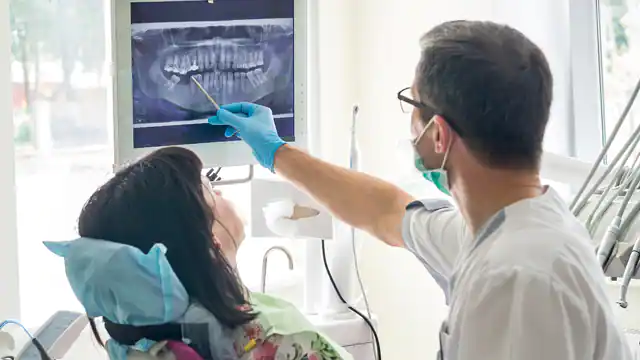Visiting the dentist can often evoke feelings of unease or anxiety for many individuals. However, one comforting aspect has always been the assurance of anesthesia, a fundamental tool in modern dentistry that alleviates the potential agony associated with dental procedures. Anesthesia has revolutionized the way we perceive dental care, transforming what was once considered a painful experience into a more comfortable and manageable one.
Yet, amid the advancements in dental technology and anesthesia, there remains a curious yet disconcerting question: What if anesthesia weren’t an option during a tooth extraction? The mere thought of enduring such a procedure without the numbing effects of anesthesia can evoke a sense of dread and curiosity simultaneously.
This article delves into this thought-provoking scenario, aiming to explore the realities of tooth extraction without anesthesia. By dissecting the role of anesthesia in dentistry, delving into the process of tooth extraction, and understanding pain perception, we aim to shed light on the potential agony one might experience without the comfort of anesthesia.
Recommended: Is Tooth Extraction a Simple Procedure?
In doing so, we hope to not only provide valuable information but also underline the importance of pain management in dentistry and how it significantly impacts patients’ experiences and overall well-being. Ultimately, this article aims to deepen our understanding of the significance of anesthesia in modern dental practices and the importance of ensuring patient comfort and safety during such procedures.
Types of Dental Anesthesia
1. Local Anesthesia
Local anesthesia is a cornerstone of pain management in dentistry. It involves the application of an anesthetic agent to a specific area, numbing the nerves and preventing them from transmitting pain signals.
Typically administered via injections, this type of anesthesia ensures that only the targeted area undergoes numbing, allowing dentists to perform procedures like fillings, root canals, or extractions with minimal discomfort for the patient.
2. General Anesthesia
General anesthesia is less common in routine dental procedures but is employed for complex surgeries or in cases where patients may require deep sedation. Administered either orally or intravenously, it induces a state of unconsciousness, ensuring that patients are completely unaware and free from pain during the procedure. This form of anesthesia is often utilized in more intricate surgeries or for patients with severe dental phobia.
The Role of Anesthesia in Dentistry
The advent of anesthesia in dentistry has significantly transformed the patient experience. Pain management is not merely about mitigating physical discomfort; it’s about fostering a sense of trust and comfort between patients and their dental care providers. By alleviating pain, anesthesia enables dentists to carry out procedures more effectively while ensuring the patient’s well-being.
Beyond the immediate comfort it provides, effective pain management contributes to positive outcomes post-procedure. Patients are more likely to recover faster and experience fewer complications when pain is managed well during and after the dental procedure. This underscores the pivotal role that anesthesia plays in ensuring not only a pain-free experience but also a smoother recovery process.
Recommended: Tooth Extraction: Preparation, Cost, Facts And Management
The integration of various anesthesia techniques in dentistry reflects a commitment to personalized care, where the choice of anesthesia is tailored to individual patient needs and the complexity of the dental procedure. It highlights the evolution of dental practices towards prioritizing patient comfort and safety, enhancing the overall quality of dental care provided.

How Painful Is Tooth Extraction Without Anesthesia?
Tooth extraction without anesthesia can be extremely painful. The procedure involves pulling or cutting into the gums and bone to remove a tooth, which can cause intense discomfort and even agony.
The nerves in the mouth are highly sensitive, so undergoing extraction without anesthesia can be excruciating and distressing. It’s important to prioritize proper pain management and seek professional dental care to ensure a more comfortable and safe experience during any dental procedure.
What Happens During a Tooth Extraction?
Overview of the Procedure
1. Pre-extraction Preparations
Before the extraction, the dentist conducts a thorough examination, reviewing X-rays and the patient’s dental history. This evaluation helps determine the best approach for the extraction. In cases of complex extractions or concerns regarding anesthesia, further discussions may occur between the dentist and the patient.
2. Anesthesia Administration
In a typical tooth extraction procedure, the dentist administers local anesthesia to numb the area surrounding the tooth. This numbing effect ensures that the patient experiences minimal to no pain during the extraction. The choice between local and general anesthesia depends on factors such as the complexity of the extraction and the patient’s preferences or medical conditions.
3. Extraction Process
Using specialized instruments, the dentist loosens the tooth from its socket in the gum and jawbone. For simple extractions, forceps are used to grasp and remove the tooth. In cases of impacted or severely damaged teeth, surgical extraction involving incisions in the gum and bone removal might be necessary.
Pain Sensitivity in Dental Patients
1. Individual Pain Thresholds
Patients’ sensitivity to pain varies widely. Factors such as previous dental experiences, anxiety levels, and pain tolerance contribute to how individuals perceive and cope with the sensations during an extraction.
2. Sensations During Extraction
Even with anesthesia, patients might experience sensations like pressure or pulling during the extraction. While these sensations are not necessarily painful, they can cause discomfort or anxiety for some individuals.
Psychological and Emotional Impact of Pain during Extraction
1. Anxiety and Emotional Response
The anticipation of pain or discomfort during a dental procedure can trigger anxiety in patients. This psychological aspect can heighten the perception of pain, making the experience more distressing.
2. Long-term Impact
Negative experiences related to pain during tooth extraction can impact a patient’s willingness to seek dental care in the future. This emphasizes the importance of effective pain management in shaping patients’ attitudes toward dental health and care.
Recommended: Can You Drink Cold Water After Tooth Extraction?
Understanding the intricacies of the extraction process and acknowledging the variations in pain sensitivity among patients underscores the significance of anesthesia in ensuring a more comfortable and positive experience during this dental procedure.
Coping Strategies for Managing Pain During Tooth Extraction
1. Mind-Body Relaxation Techniques
- Progressive muscle relaxation: Guided steps to systematically relax muscles before and during the procedure
- Visualization and guided imagery: Using mental imagery to create calming scenes or scenarios to reduce anxiety and pain perception
- Biofeedback techniques: Learning to control physiological responses to stress through monitoring and self-regulation
2. Breathing and Relaxation Exercises
- Deep breathing exercises: Instructive methods for deep, rhythmic breathing to ease tension and anxiety
- Diaphragmatic breathing: Techniques to engage the diaphragm for deeper, more calming breaths
- Controlled breathing patterns: Practicing specific breathing patterns to regulate heart rate and induce relaxation
3. Distraction Techniques
- Listening to music or guided meditation: Using audio aids to divert attention from the procedure
- Watching videos or using virtual reality: Employing immersive experiences to distract from the discomfort
- Engaging in conversation: Communicating with the dentist or assistant during the procedure to focus on something other than the pain
4. Pre-Procedural Preparation
- Mental preparation and visualization: Mentally rehearsing the procedure to reduce fear and anxiety
- Communicating concerns with the dentist: Discussing fears and apprehensions beforehand to establish trust and seek reassurance
- Taking prescribed pre-procedural medication: Following the dentist’s instructions regarding any pre-procedure medications to ease anxiety
5. Post-Extraction Self-Care
- Following aftercare instructions: Adhering to the dentist’s post-extraction care guidelines to minimize discomfort and promote healing
- Using prescribed pain relievers responsibly: Taking prescribed medications as directed by the dentist to manage post-extraction pain
- Applying cold compresses: Using ice packs to reduce swelling and alleviate pain in the extraction area
6. Seeking Emotional Support
- Having a support person present: Bringing a trusted friend or family member for emotional support during the procedure
- Seeking professional counseling: Considering counseling or therapy for dental anxiety and fear management
- Joining support groups: Finding communities or forums where individuals share experiences and coping strategies for dental procedures.
Recommended: Can You Use Bondic On Teeth? Get The Facts Before You Try
Encouraging patients to employ these coping strategies can empower them to take an active role in managing their discomfort during tooth extraction. Additionally, emphasizing the importance of open communication with the dental team can greatly alleviate anxiety and enhance the overall experience.

Instances of Tooth Extraction Without Anesthesia
Historical Practices: Dentistry Before Modern Anesthesia
1. Early Dental Procedures
In ancient times, dental procedures were performed without the luxury of anesthesia as we know it today. Practices such as using herbal remedies, primitive tools, or even physical force to extract teeth were prevalent across civilizations.
2. Traditional Remedies and Pain Management
Methods to mitigate pain during tooth extraction varied greatly. Some cultures relied on medicinal herbs or intoxicants to dull the senses, while others employed ritualistic or ceremonial practices to prepare individuals for the ordeal of dental procedures.
Rare Cases or Situations Where Anesthesia Is Not Available
1. Limited Access to Anesthesia
In some remote or underprivileged regions, access to modern anesthesia might be limited or unavailable. This could result from various factors such as economic constraints, geographic isolation, or insufficient healthcare infrastructure.
2. Emergency Situations or Natural Disasters
During emergencies or natural disasters where medical supplies are scarce, dental procedures, including extractions, might be conducted without anesthesia due to the unavailability of resources.
Cultural or Personal Choices Against Anesthesia
1. Cultural Beliefs and Practices
Certain cultural beliefs or traditions might influence individuals to opt for dental procedures without anesthesia. Some cultures perceive enduring pain as a rite of passage or view it as a test of strength or endurance.
2. Personal Preferences or Fear
In some cases, individuals might refuse anesthesia due to personal preferences, fears of needles or side effects, or a desire for a more “natural” approach to healthcare, despite the potential discomfort or pain during the extraction.
Recommended: How Long Does It Take for Dental Implants to Heal?
Understanding these instances highlights the historical context, situational constraints, and personal choices that might lead to tooth extraction being performed without anesthesia. It underscores the privilege of access to modern pain management techniques and the significance of making anesthesia available and accessible for optimal dental care in all circumstances.
Understanding Pain Perception
The Science Behind Pain
1. Pain Pathways in the Body
Pain perception involves complex interactions within the nervous system. When tissue damage or stimulation of pain receptors occurs, signals are transmitted through nerve fibers to the spinal cord and then relayed to the brain. This process involves neurotransmitters and various brain regions responsible for interpreting and processing pain signals.
2. Different Types of Pain
Understanding pain involves recognizing its various forms. Dental pain, specifically during tooth extraction, can range from sharp, acute sensations to dull, persistent discomfort. This variability in pain experiences stems from differences in nerve stimulation and individual pain thresholds.
Factors Affecting Pain Sensitivity in Dental Procedures
1. Psychological Factors
Emotional states, including anxiety, fear, or stress, can amplify the perception of pain. Dental anxiety, in particular, can heighten pain sensitivity, making the experience of a tooth extraction more distressing for some individuals.
2. Biological Factors
Individual differences in pain sensitivity exist due to biological factors such as genetics, age, and overall health. Some individuals naturally have higher pain thresholds, while others may experience heightened sensitivity to pain stimuli.
Varying Degrees of Pain Tolerance Among Individuals
1. Cultural and Personal Influences
Cultural upbringing and personal experiences shape individuals’ perceptions of pain. Some cultures emphasize stoicism in the face of pain, while others encourage seeking pain relief more readily.
2. Coping Mechanisms and Pain Management Techniques
Individuals develop various coping mechanisms to manage pain during dental procedures. Techniques such as deep breathing, distraction methods, or relaxation exercises can help mitigate the perceived intensity of pain.
Recommended: Can You Drink Milk After Tooth Extraction?
Understanding the intricate interplay between biological, psychological, and cultural factors in pain perception elucidates why individuals experience dental procedures differently. This comprehension underscores the importance of personalized care and tailored pain management strategies to optimize the dental experience for each patient.

Risks and Complications
Potential Complications Arising from Untreated Pain During Extraction
1. Increased Discomfort and Anxiety
Performing a tooth extraction without anesthesia exposes individuals to heightened levels of pain, leading to increased discomfort and anxiety during the procedure. The absence of pain management can intensify these feelings, making the experience more traumatic.
2. Risk of Trauma or Injury
The sensation of pain during tooth extraction without anesthesia might cause patients to involuntarily move or flinch, increasing the risk of accidental trauma or injury to surrounding tissues or structures.
Long-term Effects on Dental Health and Overall Well-being
1. Post-procedural Complications
Inadequate pain management during tooth extraction could lead to post-procedural complications such as prolonged bleeding, increased inflammation, or delayed healing at the extraction site.
2. Psychological Impact
Experiencing intense pain during a dental procedure can have lasting psychological effects, potentially leading to dental phobia, avoidance of future dental care, or heightened anxiety related to dental visits.
Ethical Considerations: Patient Rights and Consent
1. Informed Consent
Performing tooth extraction without anesthesia raises ethical concerns regarding informed consent. Patients have the right to be fully informed about the procedure, including the risks, alternatives, and the expected level of pain or discomfort.
2. Patient-Centered Care
Ethical dental practices prioritize patient-centered care, ensuring that patients’ preferences, comfort, and well-being are at the forefront of treatment decisions. Upholding these principles involves providing adequate pain management options and respecting patients’ choices.
Recommended: Can Mouthwash Numb Toothache?
Highlighting these risks and complications underscores the significance of anesthesia in mitigating discomfort and ensuring the safety and well-being of patients during tooth extraction. It emphasizes the ethical responsibility of dental practitioners to provide comprehensive care while respecting patients’ autonomy and preferences regarding pain management.
Alternatives to anesthesia for pain management during tooth extraction
- Nitrous Oxide (Laughing Gas):Nitrous oxide is a mild sedative administered through inhalation. It induces relaxation and reduces pain perception without rendering the patient unconscious. It is widely used in dentistry to alleviate anxiety and discomfort during procedures.
- Oral Sedatives: Oral sedatives like benzodiazepines are taken before the procedure to induce relaxation and reduce anxiety. They help patients feel more at ease and calm during dental procedures. The dosage, onset, and duration of effects should be discussed with the dentist.
- Acupuncture and Acupressure: Involves inserting fine needles into specific points to alleviate pain and induce relaxation. Utilizes pressure on specific points to relieve discomfort and promote relaxation. Research supports their use in reducing dental pain and anxiety.
- Hypnosis: A state of focused attention is induced to reduce pain perception and anxiety. Studies show hypnosis can effectively manage dental anxiety and discomfort. Seeking qualified professionals experienced in dental hypnotherapy is crucial.
- Relaxation Techniques: Help patients relax and distract from the dental procedure. Step-by-step muscle relaxation techniques reduce tension and stress. Apps or resources offering guided relaxation sessions can be beneficial.
- Localized Nerve Blocks: Numbing specific nerves to alleviate pain in the extraction area. Provides targeted pain relief during tooth extraction. Duration and depth of numbing might not cover the entire procedure.
- Topical Anesthetics: Applied directly to the extraction site for surface-level numbing. Offers temporary relief from discomfort but may not manage deeper pain.
- Distraction Techniques: Diverts attention from the extraction process. Deep breathing helps in relaxation and managing stress during the procedure. VR or AR experiences provide immersive distractions.
- Mindfulness Practices: Helps in reducing anxiety and increasing pain tolerance. Patients can learn mindfulness techniques before the procedure for better coping mechanisms.
- Breathing Exercises: Controlled breathing techniques to calm nerves and manage discomfort. Inhaling, holding, exhaling – a pattern that promotes relaxation.
Recommended: 6 Major Causes of Toothache, Their Solution And Prevention
Each of these alternatives offers unique benefits and considerations. Discussing these options with a dental professional can help determine the most suitable method for managing pain during tooth extraction based on individual preferences and the complexity of the procedure.
FAQs
Is tooth extraction without anesthesia extremely painful?
Yes, tooth extraction without anesthesia can be intensely painful as it involves the direct sensation of pressure, pulling, and potential nerve stimulation during the procedure.
Can I tolerate the pain of a tooth extraction without anesthesia?
Pain tolerance varies among individuals. While some may endure it, most find the pain unbearable due to the nature of the procedure involving nerve stimulation and physical manipulation.
Why would someone opt for tooth extraction without anesthesia?
Reasons might include limited access to anesthesia, cultural beliefs, fear of anesthesia, or personal preferences. In rare instances or historical contexts, anesthesia might not have been available or used.
How does pain during tooth extraction affect recovery?
Intense pain during extraction can lead to increased discomfort post-procedure, potentially impacting healing, and increasing the risk of complications.
Can I request anesthesia for a tooth extraction?
Yes, in modern dentistry, anesthesia options are available and can be requested or recommended by the dentist based on the complexity of the procedure and the patient’s comfort level.
Are there risks associated with undergoing a tooth extraction without anesthesia?
Yes, risks include heightened discomfort during the procedure, increased potential for injury due to involuntary movements, and long-term psychological impacts.
Conclusion
Anesthesia stands as an indispensable cornerstone of modern dentistry, offering patients comfort, safety, and precise care during dental procedures. Its evolution reflects a commitment to personalized pain management, ensuring optimal outcomes while respecting patients’ preferences and well-being.
Upholding ethical principles of informed consent and patient-centered care, the advancements and future innovations in anesthesia continue to redefine dental experiences, fostering a more positive and reassuring journey for individuals seeking oral healthcare.
